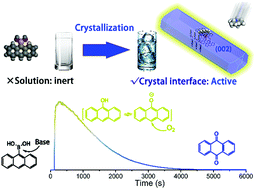Reactivity triggered by an organic microcrystal interface: a case study involving an environmentally benign, aromatic boric acid reaction†
Abstract
A novel reactivity-triggering strategy for inert organic molecules was developed via the chemical properties of a crystal-solution interface. Upon self-assembling to form a {002} crystal interface, inactive 9-anthracene boric acid was transformed into an ultra-high active state, triggering a catalyst-free, environmentally benign, aromatic substitution and oxidation reaction, which achieved 99% yield in 1 h under ambient conditions.



 Please wait while we load your content...
Please wait while we load your content...